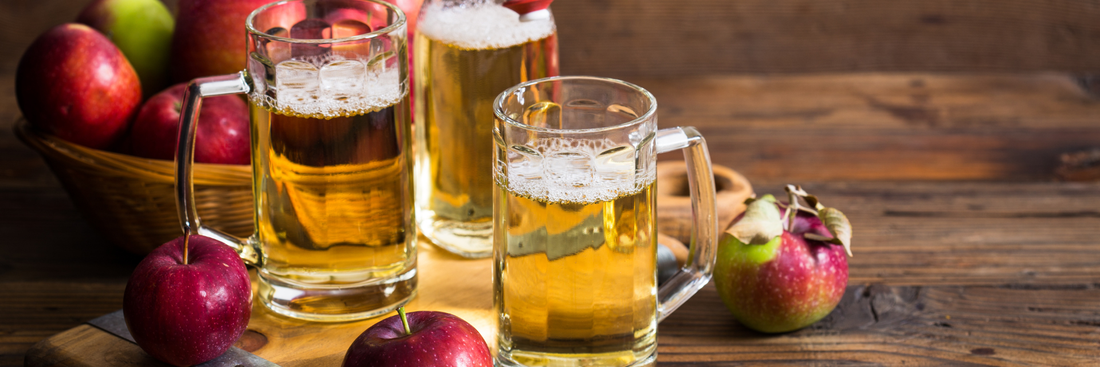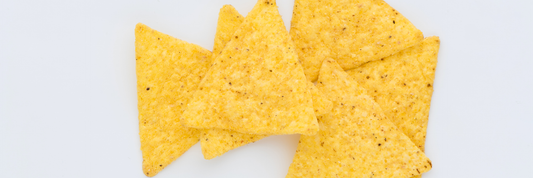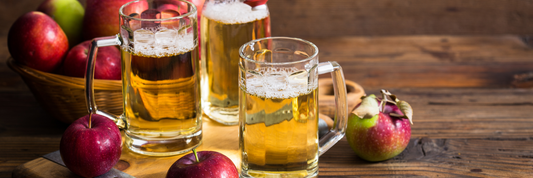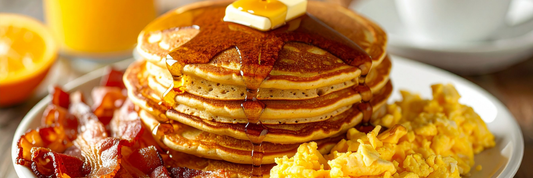When it comes to crafting great cider, choosing the right apples makes all the difference. The best apples for cider are those that balance sweetness, acidity, and tannins, creating depth, aroma, and structure in the final drink. Whether you’re making traditional hard cider or fresh sweet cider, understanding apple varieties from bittersweet English classics like Dabinett to crisp American favorites like Granny Smith; is the first step to success. In this guide, we’ll explore what makes a great cider apple, which varieties perform best, and how to blend them for a perfectly balanced batch.
What Makes the Best Apples for Cider
Key Attributes of the Best Apples for Cider
The best apples for cider are chosen for their balance of sugar, acid, and tannin, which together determine how the finished cider tastes and ferments.
-
Sugar (Brix): The sugar in apples converts to alcohol during fermentation. Good cider apples typically have 12–17% sugar content (°Brix), producing ciders between 5–7% alcohol by volume.
-
Acidity (Malic Acid): Acid adds brightness and structure. Sharp or tart apples like Granny Smith or Northern Spy provide the crisp bite that prevents cider from tasting flat.
-
Tannins: These natural compounds add body, color, and astringency. Bittersweet and bittersharp varieties are prized for high tannin content, which enhances mouthfeel and aging potential.
-
Aromatics: Apples with complex aromas (floral, spicy, or fruity) contribute depth to the cider’s bouquet.
-
Texture and juice yield: Firmer apples with dense flesh generally press better and yield clearer juice for fermentation.
Cider makers often seek a mix of apple types; sweet, tart, and tannic; because no single apple typically provides all ideal characteristics.
Cider-Apple Classification
Cider apples are grouped into four main categories based on their acidity and tannin content; a classification used widely in the U.K. and adopted by many North American cider makers:
| Class | Acidity | Tannin | Examples | Typical Role in Cider |
|---|---|---|---|---|
| Sweet | Low | Low | Fuji, Gala, Golden Delicious | Provides fermentable sugar, mild flavor |
| Sharp | High | Low | Granny Smith, Winesap, Jonathan | Adds bright acidity, freshness |
| Bittersweet | Low | High | Dabinett, Yarlington Mill, Michelin | Adds body, tannin, smooth finish |
| Bittersharp | High | High | Kingston Black, Foxwhelp | Provides complexity, depth, and structure |
Most balanced ciders combine all four categories. Bittersweet and bittersharp varieties are considered the true “cider apples” used in traditional English and French cider making, while sweet and sharp apples are often sourced from dessert apple orchards.
Best Apple Varieties for Cider
Best Sweet Apples for Cider
Sweet apples supply the fermentable sugars that drive alcohol production and balance acidity. These are typically low in tannins but high in juice yield.
Common examples include:
-
Fuji: Very sweet with mild flavor; excellent for boosting alcohol level.
-
Gala: Juicy, aromatic, and adds pleasant fruitiness to blends.
-
Golden Delicious: Soft sweetness and smooth texture; rounds out sharp ciders.
-
Honeycrisp: Modern variety with balanced sweetness and clean flavor; adds crisp aroma.
-
Cortland: Adds mild sweetness and floral notes without overpowering acidity.
Sweet apples alone make light, approachable ciders but are best used alongside sharper or more tannic varieties.

Best Tart/Sharp Apples for Cider
Sharp apples are essential for balancing sweetness and enhancing freshness. Their higher malic acid gives cider structure and longevity.
Top choices include:
-
Granny Smith: Classic sharp apple with high acid; ensures a clean, dry finish.
-
Jonathan: Tart with subtle spice; adds depth and bright aroma.
-
Northern Spy: Firm, juicy, and aromatic; ideal for dry or complex blends.
-
Winesap: Sharp-sweet balance with spice; often used in both sweet and hard ciders.
-
McIntosh: Adds mild acidity and floral tones; often used in North American blends.
Sharp apples are crucial for maintaining balance — without them, cider tastes flat or overly sweet.

Best Traditional Cider Apples
These are the heritage or heirloom varieties specifically bred or selected for cider making. They contain rich tannins and complex flavors not found in most eating apples.
Some of the most respected cider apples include:
-
Kingston Black (U.K.): Classic bittersharp apple known for producing well-balanced, single-varietal cider with rich color and full body.
-
Dabinett (U.K.): A bittersweet variety famous for smooth, rounded ciders with low acidity and strong tannins.
-
Yarlington Mill (U.K.): Fruity, aromatic bittersweet apple often blended for soft mouthfeel.
-
Michelin (France): Low-acid bittersweet apple ideal for blending with sharper varieties.
-
Ashmead’s Kernel (England): A russeted, aromatic apple that produces ciders with spicy notes and good acidity.
-
Newtown Pippin (U.S.): Historic American variety used since colonial times; aromatic with balanced sugar and acid.
Traditional cider apples often require specific growing conditions but reward makers with complex, full-bodied results.
Regional Best Apples for Cider
Different climates favor different varieties. Cider makers often select apples based on regional availability and flavor profile.
North America:
-
Best for New England & Northeast: Roxbury Russet, Baldwin, McIntosh, Northern Spy.
-
Best for Pacific Northwest: Gravenstein, Golden Russet, Winesap, Jonagold.
-
Best for Midwest & Great Lakes: Jonathan, Cortland, Liberty, Enterprise.
United Kingdom:
-
Classic cider regions like Somerset and Herefordshire rely on bittersweet and bittersharp apples such as Dabinett, Kingston Black, Yarlington Mill, and Tremlett’s Bitter.
France (Normandy & Brittany):
-
Known for complex, tannic blends from Michelin, Bedan, and Frequin Rouge varieties.
Each region adapts its blend based on climate, acidity, and local apple genetics — proving there’s no single “best” apple, only the best balance for each terroir.
How to Blend the Best Apples for Cider
Why Blending the Best Apples for Cider Often Beats Using One Variety
Cider makers almost always blend multiple apple types to achieve balance.
-
Sweet apples provide fermentable sugar.
-
Sharp apples add acidity for freshness.
-
Bittersweet and bittersharp apples contribute tannin and structure.
A single apple variety rarely provides all these qualities. By blending, you control the final cider’s alcohol strength, mouthfeel, and flavor complexity. Even professional cider houses blend 5–10 varieties per batch to fine-tune sweetness and aroma.
Typical Blend Ratios Using the Best Apples for Cider
While recipes vary, a balanced cider blend typically follows these ratios:
-
40–50% Sweet apples (e.g., Fuji, Gala, Golden Delicious) for sugar content
-
30–40% Sharp apples (e.g., Granny Smith, Winesap, Jonathan) for acidity
-
10–20% Bittersweet/Bittersharp apples (e.g., Dabinett, Kingston Black) for tannin and body

For dry or traditional English-style cider, increase bittersweet content (up to 30%).
For sweet or sparkling cider, favor sweet and sharp apples.
Example blend (home scale):
-
50% Fuji or Gala
-
30% Granny Smith
-
20% Dabinett or Kingston Black
This combination yields a crisp, full-bodied cider with balanced sweetness, acidity, and depth.
Choosing the Best Apples for Cider
Measuring Sugar (°Brix) for the Best Apples for Cider
Sugar is the foundation of fermentation, and its concentration determines both the alcohol content and sweetness of the final cider. The sugar level of apples is measured in degrees Brix (°Brix) — a unit representing the percentage of sugar in the juice.
-
Ideal Range: Most cider apples fall between 12–17 °Brix.
-
12 °Brix produces roughly 6% alcohol after fermentation.
-
15–17 °Brix can yield 7–8% ABV ciders.
-
-
Measuring: A handheld refractometer or hydrometer can measure °Brix directly from fresh-pressed juice.
-
Balancing the blend:
-
High-Brix apples like Fuji, Honeycrisp, and Golden Russet provide fermentable sugars and contribute body.
-
Low-Brix apples (like tart or sharp varieties) balance sweetness but may need blending for adequate alcohol levels.
-
Tip: The best cider blends combine apples of varying sugar levels for more controlled fermentation and smoother flavor development.
Checking Acidity & Tannin Levels in the Best Apples for Cider
The acidity and tannin content shape the cider’s freshness, mouthfeel, and aging potential. Both can be measured with simple tools or lab testing.
1. Acidity (Malic Acid):
-
Ideal range: 4.5–7.5 g/L (grams of malic acid per liter).
-
Sharp apples such as Granny Smith, Winesap, and Northern Spy fall on the higher end of this range.
-
Balanced acidity prevents cider from tasting flat and supports longer shelf stability.
2. Tannin (Polyphenol) Content:
-
Tannins add structure, bitterness, and astringency — qualities that help cider age gracefully.
-
Bittersweet and bittersharp varieties (like Dabinett, Kingston Black, or Yarlington Mill) contain high tannin levels (0.15–0.25%).
-
Too little tannin = thin, watery cider; too much = harsh or drying finish.
Testing Methods:
-
Acid testing kits (titration) measure malic acid levels accurately.
-
Tannin estimation can be done using sensory testing (taste for dryness or puckering) or laboratory polyphenol analysis.
Goal: Aim for a blend with moderate acid (pH ~3.3–3.8) and balanced tannins for the most harmonious cider flavor.
Flavor and Aroma Profiles in the Best Apples for Cider
Beyond chemistry, the aromatic compounds in apples define the cider’s personality. The best apples for cider produce juices that ferment into layered, aromatic beverages with distinctive regional character.
Common cider flavor traits by apple category:
-
Sweet apples (Fuji, Gala, Golden Delicious): Contribute fruity and floral notes, often with hints of honey or pear.
-
Sharp apples (Granny Smith, Jonathan, Winesap): Provide crisp green-apple acidity and citrus-like freshness.
-
Bittersweet apples (Dabinett, Michelin): Offer earthy, woody, or caramel tones that build depth.
-
Bittersharp apples (Kingston Black, Foxwhelp): Add spicy, smoky, or wine-like complexity with a dry finish.
A well-balanced cider typically integrates fruitiness (from esters) with acidic brightness and tannin structure, similar to wine blending.
During fermentation, natural apple aromatics transform into esters (like ethyl acetate and hexyl acetate), giving cider its signature apple aroma even after aging.
Tip: Combine both aromatic dessert apples and complex bittersweet varieties to create ciders that are both fragrant and full-bodied.
Disease, Yield, and Agronomic Traits When Selecting the Best Apples for Cider
While flavor is critical, professional and hobby cider makers must also consider the agronomic traits of cider apple trees. Healthy, high-yielding trees ensure consistent quality and supply for pressing.
Key factors include:
-
Disease Resistance: Look for varieties resistant to apple scab, fire blight, and powdery mildew. Common resilient varieties include Liberty, Enterprise, and GoldRush.
-
Yield Consistency: Some heritage cider apples (like Kingston Black) are biennial — producing heavy crops one year and light the next. Mixing annual-bearing varieties (like Dabinett or Michelin) helps stabilize production.
-
Ripening Time: Early-, mid-, and late-season apples can extend pressing windows, ensuring optimal sugar and tannin extraction throughout harvest.
-
Juice Yield: Firmer apples with dense flesh yield higher juice volumes and clearer cider. Russeted or dry-fleshed apples often deliver the richest flavor concentration.
-
Rootstock & Climate Fit: Choose cold-hardy or drought-tolerant rootstocks (e.g., M.7, G.935) depending on local growing conditions.
Practical takeaway: The best apples for cider are not just delicious — they’re reliable, disease-resistant, and well-suited to your local climate, ensuring high-quality cider year after year.
Conclusion
The best apples for cider combine the right chemistry — sugar for fermentation, acid for freshness, and tannin for complexity. While no single variety is perfect on its own, blending sweet, sharp, and bittersweet apples creates a cider with character and balance. From heritage types like Kingston Black and Newtown Pippin to accessible choices like Fuji and Gala, your selection shapes both the flavor and quality of your cider. With a thoughtful mix, you can turn simple apple juice into a refined, flavorful drink worthy of any craft cider house.







